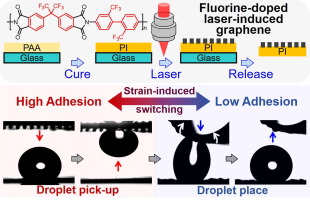
Year
2021Abstract
We present a facile direct-write approach for patterning fluorine-doped nanocarbons directly on molecularly engineered polymers for superhydrophobic and parahydrophobic surfaces. We first synthesized two different polymer films, non-fluorinated and fluorinated polyimides (PIs), by two-step procedure to create poly(amic acid) precursors, followed by thermal curing. Morphology and chemical composition were controlled by adjusting the programmed scan line pitch from 101.6 to 508 μm during lasing to achieve superhydrophobicity with a water contact angle (CA) up to 156° in the direction perpendicular to carbonized lines. Droplets exhibited strong adhesion on our porous graphene micropatterns even when held at vertical and inverted orientations, indicating a Cassie impregnating state of wetting. Parahydrophobic F-LINC with line pitch of 355.6 μm exhibits high dynamic CAs along both perpendicular (θA = 165°, θR = 127°) and parallel directions (θA‖ = 147°, θR‖ = 87°) as well as highly anisotropic CA hysteresis (Δθ = 38°, Δθ‖ = 60°). Moreover, we demonstrate strain-induced switchable adhesion by leveraging substrate curvature control. Further, we show that our micropatterned polymer films can be used for transferring droplets without any loss or contamination. Hence, our approach offers new insights into designing interfaces for droplet manipulation, pick-and-place applications, and localized control of reactions.









